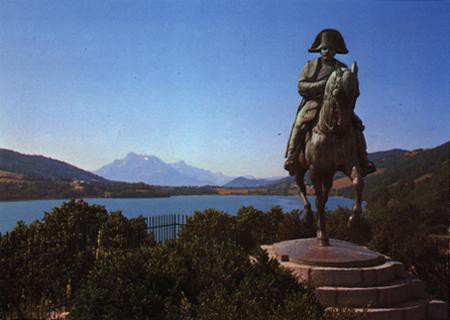On 1 March 1815, on his return from Elba, Napoleon landed in Golfe-Juan with a small band of 1100 loyal soldiers. And from here he set out on the extraordinary adventure that was to lead to the return to power two and a half weeks later, 20 March, with his triumphal entry into the Tuileries palace which had been hastily abandoned by Louis XVIII. This was the beginning of the Hundred Days.
The road christened the Route Napoléon is that taken by the Emperor from Golfe-Juan to Grenoble. As indeed Napoleon himself remarked 'Before I reached Grenoble they thought me a soldier of fortune. When I got there I became a prince'. This 200-mile route has today become a tourist attraction, marked all the way along with commemorative plaques and monuments. And in addition to the historical interest, it passes through the staggeringly beautiful scenery of the Alpes-Maritimes, Alpes-de-Haute-Provence, Hautes-Alpes and Isère departments.
On disembarking from the brig l'Inconstant, Napoleon exclaimed 'Hail, France, land of heroes'. To mark this event, there is a commemorative plaque on the quay in the port. There is also, a plaque signalling the start of the Route Napoléon and (mounted on a column erected at the side of the N7 road) a bust of the Emperor. Napoleon and his troops were initially delayed by the taking of Antibes, but that having being done they soon got en route for Cannes where they made their first bivouac (a plaque on the church Notre-Dame-de-Bon-Voyage marks the spot).
At dawn, napoleon and his men headed for Mougins. Thy halted at Mouans-Sartoux before continuing on to Grasse where they encamped at the Rocquevignon plateau, today renamed the Napoleon plateau. Three charred cypress stumps stand on the site of the bivouac. The intrepid band then marched on to the Alps. They reached Saint-Vallier where Napoleon stopped to rest on a circular stone seat around an elm. This rest is commemorated with a bust of the emperor. On leaving Saint-Vallier, the troop took the winding, mountainous path through the gorges of the Siagne – here Napoleon nearly fell down one the many cliffs in the region and a pack mule carrying gold overbalanced into a ravine.
When Napoleon reached Escragnolles, he was met by the uncle of General Mireur (an officer killed in Egypt and most widely known as the 'populariser of the Marseillaise'). The emperor gave some money to Mireur's mother. On entering the small village of Seranon on 2 March, he spent the night there. Napoleon himself lodged in the Château Broundet (these days a picturesque ruin) sleeping, fully-dressed, in Louis XIII armchair. After a few hours sleep, he again set out, this time taking the road to Castellane where he made an entrance 3 March down the faubourg Saint-Martin, preceded by military trumpets and drums. Seated upon a bay and dressed in his uniform as Colonel of the Grenadiers of the Imperial Guard, he was greeted with cries of 'Long live the Emperor'. Continuing along the col de Lèques, the troop reached Barrème where Napoleon dined and spent the night in the house of the judge Tartanson.
On the morning of 4 March they again set out, this time via the mountain road to Digne, arriving there in the early afternoon and preceded by drums. They continued on their way to Malijai, where Napoleon spent the night at the Château Noguier. On 5 March, after a halt at Volonne lodging in the Auberge du Poisson d'or (today the Hotel Touring), the Emperor made his entrance into the town of Sisteron, and he received the towns worthies at the Auberge du Bras d'or. A young woman offered him a tricolour which she herself had embroidered and he kept it right up until Waterloo. The journey then continued on via La Saulce and La Tourronde to Gap where they halted for the night. There was a triumphal entry into Gap and from the Auberge Marchand where Napoleon was lodging he could hear, long into the night, the locals celebrating his return.
Leaving Gap at 6 in the morning, they went on past Saint-Bonnet (a plaque with bronze eagle and medallion mark his passing) to Corps where Napoleon set up in the Hôtel du Palais for the night. The following day at Laffrey, in the place known as the 'pré de la Rencontre' (the field of the Meeting), the famous meeting between Napoleon and the soldiers of the 5th Regiment of the Line who had come from Grenoble. The emperor, followed by Bertrand and Cambronne, advanced, whilst the Grenadiers lowered their rifles to signify that they came in peace.
Napoleon then uttered the famous words 'Soldats, me reconnaissez-vous? S'il en est un parmi vous qui veuille tuer son Empereur, me voici' (Soldiers, do you recognise me? If there is one amongst you who wishes to kill your Emperor, here I am). A rallying cry rose up amongst the soldiers and there were emotional scenes as the two platoons became one. Stendhal, after a pilgrimage to the site in 1838 later wrote: 'here was decided the fate of one of the most romantic and noble enterprises of modern times'. He also predicted that a statue of the Emperor would one day grace the site, as indeed was to occur. The statue by Fremiet of Napoleon on horseback, which today overlooks Lake Laffrey, was first erected in the Place d'Armes in Grenoble, later mothballed in 1870 and subsequently re-erected in its present position in 1929.
After the 'meeting' at Laffrey, the progress became a triumphal march passing through towns redolent of recent history: Vizille where the French Revolution began, Tavernolles, Eybens, and finally Grenoble on 7 March 1815. Here Napoleon lodged in the Hôtel des Trois Dauphins (today the Hotel Napoleon). Then it was the return to Paris. And, as Balzac was to describe it, 'once again, France gave herself to Napoleon, just as a pretty girl abandons herself to a Lancer'.
The Route Napoléon


